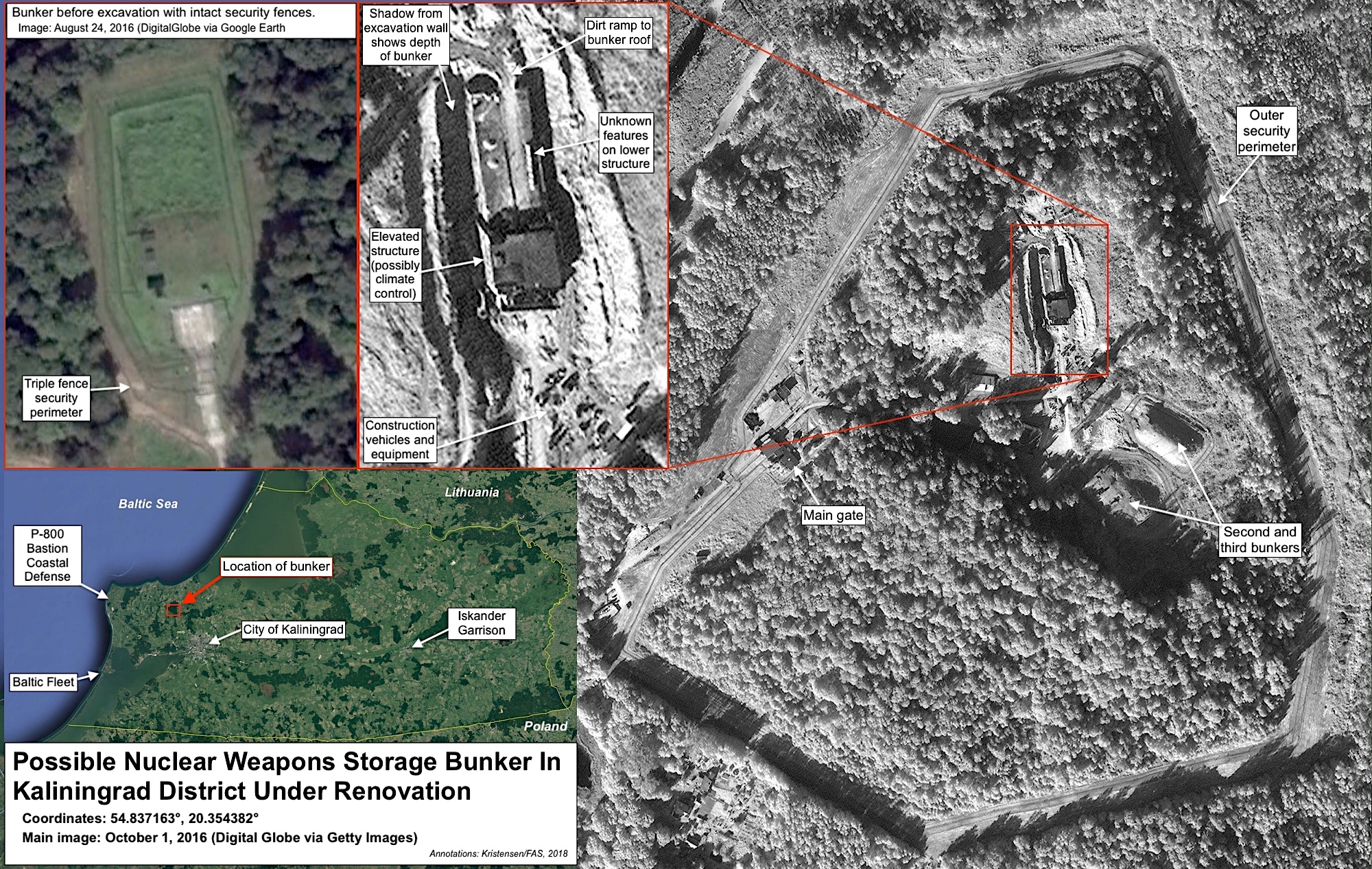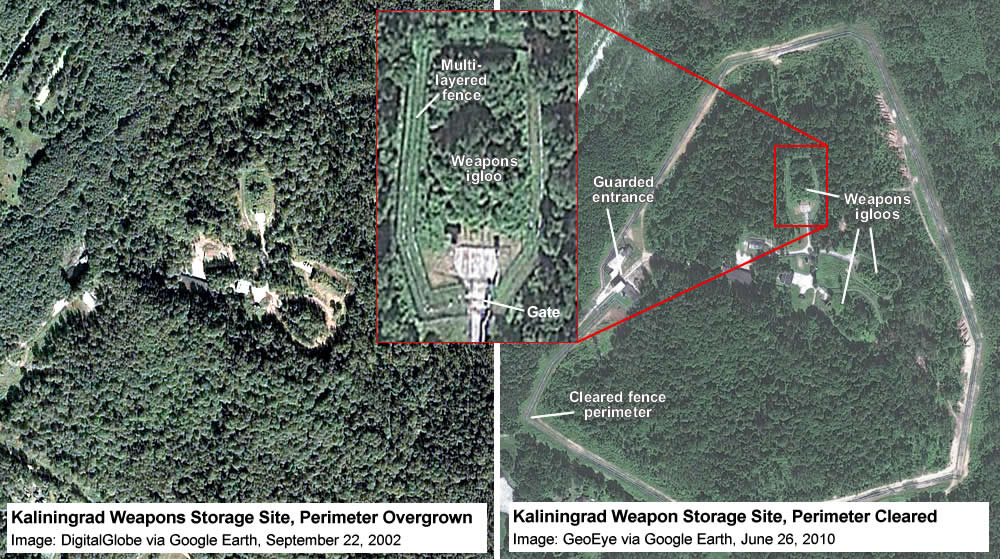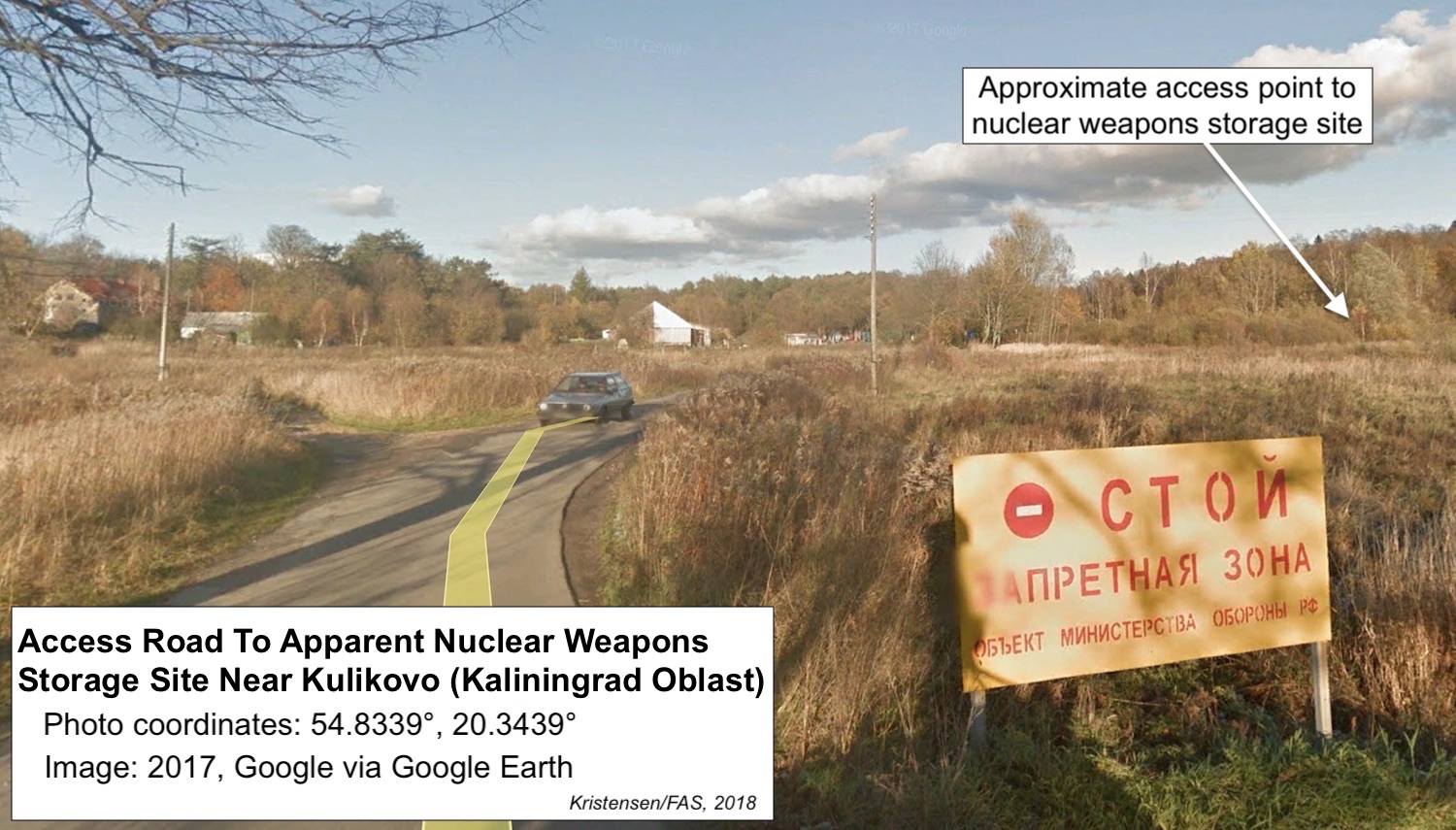Russia Upgrades Nuclear Weapons Storage Site In Kaliningrad

A buried nuclear weapons storage bunker in the Kaliningrad district has been under major renovation since mid-2016. Click on image to see full size.
By Hans M. Kristensen
During the past two years, the Russian military has carried out a major renovation of what appears to be an active nuclear weapons storage site in the Kaliningrad region, about 50 kilometers from the Polish border.
A Digital Globe satellite image purchased via Getty Images, and several other satellite images viewable on TerraServer, show one of three underground bunkers near Kulikovo being excavated in 2016, apparently renovated, and getting covered up again in 2018 presumably to return operational status soon.
The site was previously upgraded between 2002 and 2010 when the outer security perimeter was cleared. I described this development in my report on U.S. and Russian non-strategic nuclear weapons from 2012.

Between 2002 and 2010, the security perimeter around the Kulikovo nuclear weapons storage site were cleared and upgraded. Click on image to view full size.
The latest upgrade obviously raises questions about what the operational status of the site is. Does it now, has it in the past, or will it in the future store nuclear warheads for Russian dual-capable non-strategic weapon systems deployed in the region? If so, does this signal a new development in Russian nuclear weapons strategy in Kaliningrad, or is it a routine upgrade of an aging facility for an existing capability? The satellite images do not provide conclusive answers to these questions. The Russian government has on numerous occasions stated that all its non-strategic nuclear warheads are kept in “central” storage, a formulation normally thought to imply larger storage sites further inside Russia. So the Kulikovo site could potentially function as a forward storage site that would be supplied with warheads from central storage sites in a crisis.
The features of the site suggest it could potentially serve Russian Air Force or Navy dual-capable forces. But it could also be a joint site, potentially servicing nuclear warheads for both Air Force, Navy, Army, air-defense, and costal defense forces in the region. It is to my knowledge the only nuclear weapons storage site in the Kaliningrad region. Despite media headlines, the presence of nuclear-capable forces in that area is not new; Russia deployed dual-capable forces in Kaliningrad during the Cold War and has continued to do so after. But nearly all of those weapon systems have recently been, or are in the process of being modernized. The Kulikovo site site is located:
- About 8 kilometers (5 miles) miles from the Chkalovsk air base (54.7661°, 20.3985°), which has been undergoing major renovation since 2012 and hosts potentially dual-capable strike aircraft.
- About 27 kilometers (16 miles) from the coastal-defense site near Donskoye (54.9423°, 19.9722°), which recently switched from the SSC-1B Sepal to the P-800 Bastion coastal-defense system. The Bastion system uses the SS-N-26 (3M-55, Yakhont) missile, that U.S. Intelligence estimates is “nuclear possible.”
- About 35 kilometers (22 miles) from the Baltic Sea Fleet base at Baltiysk (54.6400°, 19.9175°), which includes nuclear-capable submarines, destroyers, frigates, and corvettes.
- About 96 kilometers (60 miles) from the 152nd Detachment Missile Brigade at Chernyakovsk (54.6380°, 21.8266°), which has recently been upgraded from the SS-21 SRBM to the SS-26 (Islander) SRBM. Unlike other SS-26 bases, however, Chernyakovsk has not (yet) been added a new missile storage facility.
- Near half a dozen S-300 and S-400 air-defense units deployed in the region. The 2018 NPR states that Russian’s air-defense forces are dual-capable. These sites are located 20 kilometers (13 miles) to 98 kilometers (60 miles) from the storage site.
So there are many potential clients for the Kulikovo nuclear weapons storage site. Similar upgrades have been made to other Russian nuclear weapons storage sites over the base decade, including for the Navy’s nuclear submarine base on the Kamchatka peninsula. There are also ongoing upgrades to other weapons storage sites in the Kaliningrad region, but they do not appear to be nuclear.

A Google street-view image from 2017 shows a military stop sign at the approach to the suspected nuclear weapons storage site north of Kaliningrad. Click image to view full size.
The issue of Russian non-strategic nuclear weapons has recently achieved new attention because of the Trump administration’s Nuclear Posture Review, which accused Russia of increasing the number and types of its non-strategic nuclear weapons. The Review stated Russia has “up to 2,000” non-strategic nuclear weapons, indirectly confirming FAS’ estimate.
NATO has for several years urged Russia to move its nuclear weapons further back from NATO borders. With Russia’s modernization of its conventional forces, there should be even less, not more, justification for upgrading nuclear facilities in Kaliningrad.
Additional Resources:
This publication was made possible by generous grants from the John D. and Catherine T. MacArthur Foundation, Ploughshares Fund, New Land Foundation, and the Carnegie Corporation of New York. The statements made and views expressed are solely the responsibility of the author.
Satellite imagery has long served as a tool for observing on-the-ground activity worldwide, and offers especially valuable insights into the operation, development, and physical features related to nuclear technology.
This report outlines a framework relying on “Cooperative Technical Means” for effective arms control verification based on remote sensing, avoiding on-site inspections but maintaining a level of transparency that allows for immediate detection of changes in nuclear posture or a significant build-up above agreed limits.
The grant comes from the Carnegie Corporation of New York (CCNY) to investigate, alongside The British American Security Information Council (BASIC), the associated impact on nuclear stability.
Satellite imagery of RAF Lakenheath reveals new construction of a security perimeter around ten protective aircraft shelters in the designated nuclear area, the latest measure in a series of upgrades as the base prepares for the ability to store U.S. nuclear weapons.